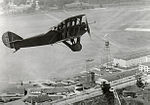The Dayton Biltmore Hotel
1929 establishments in OhioBeaux-Arts architecture in OhioBowman-Biltmore HotelsHotel buildings completed in 1929Hotel buildings on the National Register of Historic Places in Ohio ... and 3 more
Hotels established in 1929National Register of Historic Places in Montgomery County, OhioSheraton hotels

The Dayton Biltmore Hotel is a historic former hotel built in 1929 and located at the junction of First and Main Streets in downtown Dayton, Ohio, United States. It was converted to senior citizen housing in 1981 and named a federal historic site in 1982.
Excerpt from the Wikipedia article The Dayton Biltmore Hotel (License: CC BY-SA 3.0, Authors, Images).The Dayton Biltmore Hotel
I 75, Dayton
Geographical coordinates (GPS) Address Nearby Places Show on map
Geographical coordinates (GPS)
| Latitude | Longitude |
|---|---|
| N 39.771388888889 ° | E -84.191944444444 ° |
Address
I 75
45423 Dayton
Ohio, United States
Open on Google Maps









